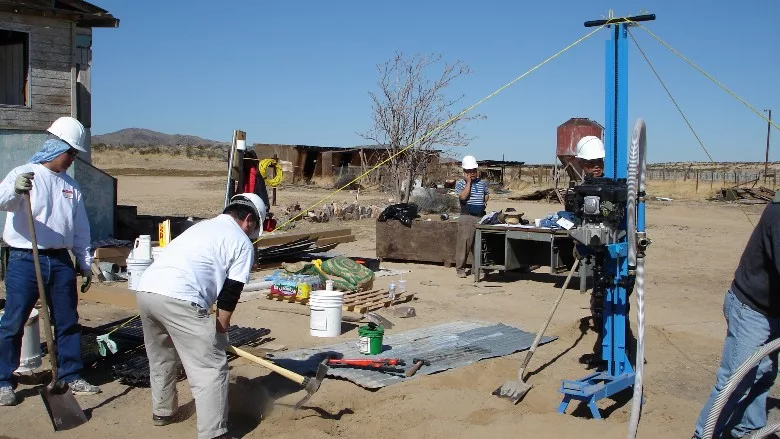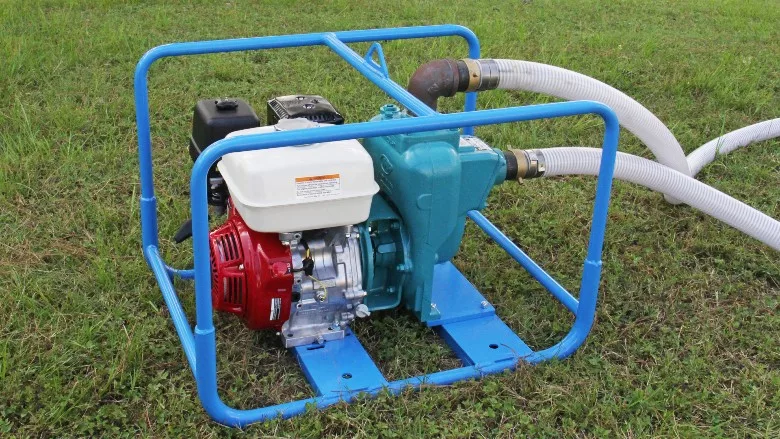Tips for Selecting a Quality Water Well Drill
On Portable Drill Rigs, Check Engines, Pump and Construction

Operators should expect the same quality, whether they work with a small, man-portable drill rig or a million-dollar truck-based one.
Source: Lone Star Drills

A high-quality pump can make or break a job. Look for a model that supports the type and scale of drilling you’ll do most.
Source: Lone Star Drills
With a wide variety of water well drills available online, it can be difficult to discern which features provide the best return on investment. As with bargain shopping, most items sold at discounted rates are cheaper for a reason. The headaches and downtime that come with addressing breakdowns, insufficient parts supply, poor support and premature failure often render the low initial investment useless. Cheaper is rarely better when it comes to the cost of a quality product. One way to protect your drill investment is to look for specific features that indicate the drill will be reliable and efficient for years to come.
The Powerhouses of the Drill
Mud rotary drilling is one of the fastest, most efficient methods of drilling today with superior penetration rates for a wide range of soil conditions. When using a mud rotary drill, one of the most essential components in the drilling process is the mud pump. The mud pump provides the power needed to clear the hole of cuttings — broken bits of solid material — that might otherwise hinder drilling.
When purchasing a mud rotary drill, it will come with two engines. One engine is used for the rotary or hydraulic system while the second engine controls the mud pump to ensure the unit will operate at optimum speed and efficiency for the application. Some manufacturers skimp on production costs by using small, underpowered engines on the mud pump, the rotary or hydraulic system, or both. This means the engine is always working harder to get the job done, which causes faster wear and increases the amount of servicing and repairs.
It’s important to note that a high-quality engine on the drill can only do so much if there isn’t a high-quality mud pump to support it. Although it might be tempting to buy a drill package with a cheap mud pump or to overlook this critical component, cutting corners can result in poor performance if the mud pump isn’t able to adequately support the drilling function.
Although it might be tempting to buy a drill package with a cheap mud pump or to overlook this critical component, cutting corners can result in poor performance if the mud pump isn’t able to adequately support the drilling function.
For shallower drilling projects, 5.5 horsepower engines should get the job done. These drill packages provide a maximum flow of 165 gpm and produce a maximum head of 100 feet. Some manufacturers offer packages for larger drills with mud pumps that provide up to 13 horsepower for achieving depths of up to 300 feet. These types of drill packages are designed to dig deeper, with engines that power the mud pump for a maximum flow of 200 gpm and a 2-inch suction and discharge that produces a maximum head of 190 feet. For added convenience, check to see if your manufacturer offers both gas and diesel engine options so you can choose which works best for you.
Choosing a quality drill package from a reputable manufacturer means the mud pump will provide optimal performance in demanding environments and the highest productivity when paired with the drill.
Construction is Key
Like the engines and mud pump, the construction of a water well drill can easily make or break a job when it comes to efficiency and ROI. Although drills might not look much different on the outside, taking a deeper look into specs — including the materials used during construction — can help make a quality water well drill stand out from the competition.
Drills with heavy-duty welded steel frames ensure optimal longevity and performance, but some manufacturers cut corners by using thinner steel. Although this can work for less intense projects, the low-quality design can cause the frame to bend and twist easily or show signs of premature wear due to corrosion from hot, humid climates. Thinner steel drills fail to stand the test of time with repetitive use, especially for heavy-duty jobs.
In addition, look for manufacturers that use 2-inch-diameter drill pipes and connections made of heat-treated alloy steel. This is ideal in demanding environments and ensures fewer replacements down the road. Some manufacturers cut costs by using irrigation-type pipes measuring only ¾- or 1-inch in diameter. These smaller pipes are intended for less intense applications like sprinkler installation and can break off when used in demanding environments, which can cause delays and other frustrations like re-drilling.
On top of quality construction, look for a user-friendly design that will support ease of operation and simplify routine maintenance. This includes conveniently located greasing points, and access to check and adjust the drill’s tension. Maintaining the drill chain tension will increase the life of the drill because excessive tension can cause faster wear or chain overload, and too much slack poses the risk of skipping a sprocket tooth. A design that provides easy access to maintenance will save time and frustration when it comes to keeping the drill in mint condition. Some drill packages are even constructed with a trailer-mounted design for convenient portability in remote areas or rugged terrain.
The Finishing Touches
In addition to finding a quality water well drill, no purchase is complete without selecting a rotary drill bit, which is critical to both longevity and performance. Using a bit that aligns with the soil conditions prevents wear and tear by helping the drill power through the soil. This can save money on drill and bit replacements in the future. Make sure the manufacturer has a variety of bits available to provide optimal performance based on the soil type.
If you will be using a hydraulic drill on hard rock formations like quartzite, granite or basalt, adding a down-the-hole hammer will allow for maximum efficiency. This product uses percussive operation and an air-powered hammer to transfer energy through carbide teeth to shatter the rock surface, while the compressed air blows away small rock fragments. A quality drill will have accessories available like down-the-hole hammers and drill bits to help maximize power and extend its life by helping the drill operate efficiently.
Don’t Forget Training
Although it’s not a tangible part of the drill, finding a manufacturer that provides training and support beyond the purchase is another sign of quality. When researching different companies, look for manufacturers that offer training manuals, videos and technical support. Some manufacturers even offer replacement parts and refurbishment options after extended use to increase the lifespan of the drill.
Proper training helps operators become familiar with equipment and provides a hands-on opportunity to view the drill and learn safe operation and maintenance procedures. It can also build an understanding of the distinct roles of the individual drill team members. This, in turn, minimizes confusion regarding individual responsibilities and reduces injuries on the job. Some manufacturers host training sessions at their facility and offer water well drill kits with necessary accessories to ensure operators get the most out of the drill.
Find out what's new in the water well market
By narrowing down the criteria for selecting a quality water well drill and focusing on features like a reliable mud pump, strong construction, excellent training and a variety of available accessories, operators and businesses will be set for long-term success. Using a quality water well drill will not only increase efficiency, it will also minimize downtime from repairs and maximize ROI.
Looking for a reprint of this article?
From high-res PDFs to custom plaques, order your copy today!





